I never thought about how good water filters were until I ordered a ZeroWater filter and it included a water testing tool. They claim their filter results in water with 0 PPM (parts per million). The higher the number means more particles and contaminants that not only make water taste bad but can also be bad for your health. It’s time for an experiment.
I tested my tap water, a bottle of spring water, and the ZeroWater filter:
My tap water clocked in at 159 PPM. Is that a good number? Apparently the World Health Organization says that water with a TDS (total dissolved solids) of 1,000 PPM is “acceptable” and under 600 PPM is “good.” Yeah, maybe if you’re living in a tent in Africa it’s good but for us fussy Americans we want crystal clear drinking water without any off-flavors. The higher the PPM number means the worse it will taste. The bottle of Acadia Natural Spring Water was much better at 24 PPM. And my new ZeroWater filter, as promised, clocked in at 0 PPM. Guess it’s not marketing fluff after all.
I have two other water filters in my house–My refrigerator’s water filter (uses a PUR filter) and a Dr. Mercola filter that was pretty expensive. In full disclosure, the refrigerator filter was replaced 2 months ago and the Dr. Mercola filter has about 5 months of use on it. The refrigerator filter definitely gets more use than the Dr. Mercola filter. The results really shocked me:
My refrigerator PUR water filter is worse than my tap water at 171 PPM! How can that be?
Shouldn’t it be removing something?
The worse rating goes to the expensive Dr. Mercola Pure & Clear drinking water filter which clocked in 178 PPM. It’s probably only fair to test the filters when they are brand new but I would still think that even if they are a few months old it shouldn’t be adding anything to the water.
I really like companies that back up their product claims, and the fact that the ZeroWater filter included a TDS water testing tool speaks volumes. The instructions say to replace the ZeroWater filter once it gets to 6 PPM. Maybe they should tell that to the entire water bottle industry.
Continue reading What’s in my Water – Part 2
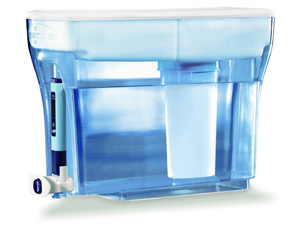
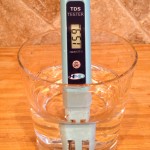
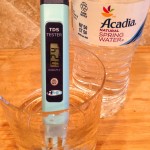
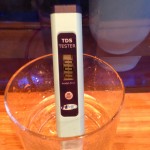
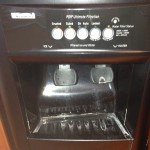
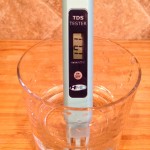
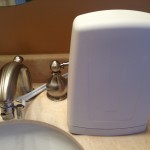
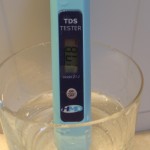
I just borrowed a friends TDS tester. My tap water was at 59 so I tested my fridge filter and it was at 87. This shocked me and I changed the filter(it was over due) let about 10 glasses run through to purge the filter. Reading 245. did about 20 more glasses to purge it and got it down to 120 where it has stabilized. Brand new whirlpool filter. Scary stuff they are selling us. Guess I’ll either get a zero water or just drink my tap. That number 59 sounds pretty good right now. Think I paid $75 for a box of 2 whirlpool filters
Thanks for sharing your results. I still highly recommend Zero Water filters. I have one at the office and at home.
Well here in Abbotsford, where we flush our toilets with (today’s reading) of 12.4 ppm, it seems foolish to filter any of it.
I just got the zero water filter for the house. In the past we used the bobble but I haven’t been able to find the filters and I like clean water to drink. I am picky about the water I do drink. I love it…. my city water was 230 ppm and it went to 0. I am looking in to the ppm differences in other brands and they don’t seem to be as good. I am interested if my husband can taste the difference also since he drinks alot of tap water I can no stand it.
You guys need to realize that most water filters that are on your fridge or most filter pitchers are simply carbon and mesh filters designed to take out large particulates and things like chlorine and and some heavy metals. They make no claims of removing minerals and softening your water. For that you have 3 options, reverse osmosis, ion exchange, or distillation. The only one of those processes that can be done in a pitcher is ion exchange, and that’s what zero water does,,,, it’s a great filter, just don’t use the tds meter on other filters and expect them to lower total dissolved solids also, its not what they are designed to do.
You nailed it! The most proper and conventional method of getting water to 0.00ppm is through steam distillation which I pretty doubt these so-called purifiers can do. And hey…for those who think that drinking water at 0.00ppm is ideal and safe…think again. Drinking demineralized water overtime can affect your health because the vital compounds and minerals in the water which the body needs have been stripped off the water.
Only about 5% of our minerals, though. The problem can be easily solved, in a quite healthy way, by simply adding a pinch of Himalayan Sea Salt (the ancient, pink kind) which contains almost the exact ratios of minerals that our bodies do, and with a few additions for more important minerals that most people (in the US at least) are deficient in can also be added to the mixture if needed. It’s a very small problem, and possibly the easiest thing to fix – like the adding of a pinch of salt to a recipe, which is the easiest step aside from eating it!
(And by “pinch”, I do mean a measured amount appropriate for the amount of water you’re adding it to, of course. But you quickly get a good perception that is more than “good enough” to solve the mineral issue.)
Sea salt of any kind would work as well, of course, and likely is fine – but if you get the salt from sources that are ancient and have been hidden from pollution for millions of years or at least thousands, you have a better quality and healthier solution – because our sea water is declining rapidly in its quality and the sheer amount of “bad stuff” from oil spills, plastic, and waste dumping into the ocean. We need to solve those issues quickly, no doubt, but in the meantime…
I have been using zero water since it came out. I lived upstairs so i never tired carrying up a 5 gallon bottle of spring water. I just moved and quickly bought 5 gallons and a crock-pot with tap. Since i have a PPM gauge that came free with my zero-filter refrigerator unit.. 395 ppm came back, my tap is 145. i will not be saving any money on filters with spring water. I feel disgusted as Spring Water is usually seen as the better water. Use those ppm meters folks.. I wish i had mine on me before i blew $50 on toilet water.
I wouldn’t worry too much about spring water readings as those are natural minerals that you are picking up in there. Don’t get me wrong, I love Zero Water and have been using it for years, but spring water is unfiltered natural source water.
Steve – Not necessarily. It’s unregulated, so consumers just don’t know unless they do a lot of research and actually find a company that is trustworthy and stays that way as it grows (which is almost impossible). Most bottled “spring water” is simply tap water – even Poland Spring, which has a HUGE source of high quality spring water, was using tap water instead to save money. Bottled water is a very inefficient, and possibly far less healthy, option (because of the chemicals in plastic, and the fact that loopholes exclude water and any “natural” product from FDA, USDA, etc regulation on quality. Which we need, because the companies, by law, HAVE to do was is most profitable as long as it can be legally justified or the penalties are not enough to offset the profit motive.
I’m really glad I found this post. I thought it was just me. I bought a zero water filter which came with a meter. I have a PUR water filter on my kitchen faucet with a brand new filter installed. Testing the water several times a day for over a week, the PUR water filter results (185) are consistently higher than my unfiltered town water (174). I removed the PUR and will never buy another product of theirs. I also tested my water cooler (20 liter, Polar Artic Water from BJ’s). It also consistently read 0.0 ppm. All tests were conducted using glass not plastic containers.
I know this is an old article… But I see in some of the comments people are using their TDS water and not quite understanding how it works…
Just because your TDS reading is high after using a filter doesn’t mean that the water is not clean great tasting water. TDS reads the minerals and the right filter will remove all of the harmful minerals while leaving some which will give you a higher TDS reading then what you expect.
On 4-6-16 my tap water taste funny like when as kid drinking out of the water hoes. Next day gotten sick maybe from the food or water was drinking all day. So sister gotten one these water zero my tap water was 860 ppm on 4-7-16 @ 4pm and @ 7pm it was 742 ppm. Now have new readings today @ 3pm it’s at 242 ppm..
I stumbled across this post through a Google search on TDS and drinking water. My LG RO water filter gives water with a TDS of about 8 ppm, which I think is pretty good for an RO filter, although it isn’t as good as the Zero Filter you’ve mentioned.
In our state (West Bengal, India), arsenic contamination is a growing concern so I thought that an RO filter would be a good investment.
Well well well i have the zero water filter it’s amazing how everyone wants 0 on TDS dont u no your meant to have things like calcium / good minerals left in the water? Zero water strips it all away
How about checking the Ph Level it can also make u ill its soo low 5.0 / 5.5 also ive brought loads of replacement filters and i have to change it every 2 months
Type in Zero Water Fishy smell because it smells disgusting when the filter runs out almost sickening so make sure u dont drink it once u smell that
City tap water does not have calcium / good minerals. Only bad things are collected from aging underground pipes that route to your home from your water treatment facility. I want pure clean water and I’ll eat healthy foods for the calcium / good minerals.
+ you can always remineralize.
The results are really convincing. Thanks Todd for sharing this. Great post!
my tap water TDS is 600ppm is it safe to drink.
Yes, under 1000 ppm is acceptable per World Health Organization.
no it needs to be under 100 way under 100
Purchased a zero water filter system w/meter a couple of months ago for the office and can’t believe the difference in taste from my newly purchase refrigerator with water dispenser. I tested the refrigerator water and the faucet water and was not impress with the results compared to the zero water.
It’s a great filter!
I was shocked to see some xheap “purified water” from Aldi clocked in at 3 ppm…gallon states deep well ocala florida…filtered by reverse osmosis micronfiltration and uv lightning….ive been drinkimg tap my whole life…no problems other than high blood pressure though! Ive also found those water machines by Culligan for 27c per gallon sre pretty.good too. I get a reading about 9 ppm…when i test.mine on occasion…but as someone noted above! We want ‘some’ minerals left in our water! So im curious how low is too low…next up ill be getting a ph meter!
Ada, 3 PPM is almost perfectly clean, too clean in fact, it should be remineralized a bit to offset the leaching of minerals from your body when you drink too much “near-distilled” water.
I get 4PPM out of an almost new filter on my ZeroWater pitcher, FYI – and my city water in rather rural NH is well over 600 PPM – which is “decent” for the standards of Africa, with their horrible water issues. THAT is unsettling, to say the least!
After going through most of the research material, i think 400 ppm and below water is okay to drink. I pains takingly spent countless hours learning about water, so I figured I discuss my experience.
I am baffled by how little we know about water when I first started to learn about an year ago. I read through this thread thoroughly and found that some of you guys are not paying attention to key things when considering filters.
Let me start by saying – ANY FILTER IS BETTER THAN NO FILTER AT ALL. When talking about water filters, there are many layers in water filter. In the case of Zero Water Filter, it’s 5 stage water filter system with Ionic Exchange being last stage. (Ionic exchange removes chemically bonded impurities out of water also.) In general, more stages you have in water filter system, more refined the water is. I Highly recommend installing “Whole house filtration system”, some cost as little as penny for 10 to 100 Gallons. (This helps in making our PITCHER Purifier last long. keurig, electronic appliances and other things also get reasonably protected) It is recommended to to leave some minerals and salts behind. When buying water filters these are the things I would definitely look for – * Does filter remove below things or not –
LED, CHLORINE, MERCURY, INDUSTRIAL POLLUTANTS, PESTICIDES, PHARMA, CYSTS or MICROBIAL
* I also check if filter is economical or not –
– Zero Water filter is rated only at 15 Gallons (Filter being about $15, That’s about $1 a gallon. Things to keep in mind if you use this … Safe for kids but since you are removing all minerals and salts, it’s important to give kids with good multivitamin that has minerals and salts. If you are not able to give, avoid this filter.)
– PUR Pitcher Water Filter is rated at 40 Gallons. (3 Stage system)
(So, I use PUR Pitcher water for cooking purpose and Zero for drinking. PUR is Reasonably economical at 20 cents per gallon on Filter. )
HoLife water filter – HoLife Replacement Water Filter, Alkaline 7 Stage Mineral Water Filter Cartridge for Holife Brita Water Pitchers, 3 Count for $19 on Amazon is bargain for getting ALKALINE WATER.
*** I would buy all three water filters for various purposes.
In last 5 years my health improved drastically because of paying attention to water and filters. (Avoid bottled water. Don’t let any water in plastic hit Sun’s UV rays or hot substance, even if it’s BPA free bottle.)
Thank you Garry. Great research, great reply.
I would recommend you just add a bit of Himalayan Sea Salt or other salt mined from protected deposits that haven’t been affected by pollution. It’s not expensive, especially with how little you need to remineralize it. Don’t use vitamins, most are completely ineffective and unabsorbed by the body – unless you like to do hours upon hours of research on your provider and their source, and continue to do so on a regular basis – you’d go nuts.
A number of studies done in the last 15 or so years have shown that a staggering number, something like 97%, of “natural” vitamins don’t do what they claim to, and don’t contain the “right” kinds of the minerals we need and how we need to absorb them, which often involves fat, because that absorbs more minerals we can use than water does. Just look at how many vitamins for magnesium contain magnesium oxide, which is totally un-absorbed by the body (almost). The same is true for many, if not most, things they put in “vitamins”. The whole industry has become almost list a scam contest, since it’s an unregulated loophole and very profitable to prey upon people in bad health that are desperate.
Jared you seem like a well-informed guy who does a lot of research on what he puts in print have you ever researched the Himalayan salt to see if it really comes from where it is advertised and if it is researched extensively or is it just another scam
I bought a Zero Water filter for the tester that just has a light only designation to test my Alexapure filter. The light came on indicating the need to change the filter which has a max capacity of 5000 gal & which had just recently been installed. Surprise for me! Then I followed the instructions for the ZeroWater and had the same result. I am getting a digital tester to make sure of the purity. May be this tester is defective.
I got a few readings in the range of 85 thru 90 ppm. This was my tap water which I don’t use to drink only use to cook. Guess it’s not as bad as I expected? Little town U.S.A.
How many PPM is safe to drink? That depends on what it is. As one example, the EPA and WHO say that 1 PPM of arsenic is too much.
“EPA set the arsenic standard for drinking water at 10 ppb (or 0.010 parts per million).”
https://www.epa.gov/dwreginfo/chemical-contaminant-rules
“Drinking water from bedrock wells, also called drilled or artesian wells, and less frequently from shallow or dug wells, may contain arsenic.”
http://www.mass.gov/eea/agencies/massdep/water/drinking/arsenic-in-private-well-water-faqs.html
“The greatest threat to public health from arsenic originates from contaminated groundwater. Inorganic arsenic is naturally present at high levels in the groundwater of a number of countries, including Argentina, Bangladesh, Chile, China, India, Mexico, and the United States of America. ”
http://www.who.int/mediacentre/factsheets/fs372/en/
Don’t drink water having TDS level less than 50-100 PPM because it would not have the essential minerals and so it would be bad for your health.
100-300 PPM TDS is very good level for water.
You’re right, but WHAT is making up that PPM is what actually matters. If you’re using bad tap water, you still end up with tap water that has 100 PPM of similar ratios of harmful toxins, prescription medication (the chemicals that remain after it’s metabolized and put down the toilet), and other things you don’t want to be drinking (fluoride is another, but that gets controversial quickly so I just tell people to look at the rest of the world and their assessment of adding fluoride, a seriously toxic mineral in anything but the tiniest amounts, to the water that people consume a lot of every day. Even baby formula warns not to use fluoridated tap water… if that’s not a tacit admission that “they” know it’s not a healthy practice in the least, I don’t know what is!) You will find a LOT of disinfo sources and studies, if you look it up, that says it’s not only fine but beneficial – yet any scientist worth their “Salt” can take a look at them and the actual practice and find that the well done studies are the correct ones, and they’re also the ones that came after the information age and almost all are international, since the US flouride industry DOES NOT want people to find out they’ve been being poisoned their whole lives for almost no reason – a margin-of-error level of decreased tooth decay. Topically applying fluoride in toothpaste is probably ok if you rinse well and don’t over-do it, but systemic, uncontrolled consumption of various forms of fluoride they add to tap water in many parts of the US is so insane people have a really hard time accepting that it’s a crazy practice – hence most of the rest of the world not bowing down to US pressure, even in the 50’s and beyond, because their studies showed the opposite of those funded by the very people pushing fluoridation of water.
This is just some info for you or others to explore if you want to, I’m not interested in debating it at this point because it just becomes silly to try and convince someone of something anonymously online, they have to trust you and you ability to research first. So, please people, let’s not get into the fluoride debate – just look into it and decide for yourself, that’s the best I can help foster – but don’t do it if you’re not well versed in sourcing and interpreting scientific studies and how they need to be done to be “legit” (controls, long term studies and follow ups, who is funding it, etc).
I have RO system… tested the water and came at about 17PPM. TAP water at about 378 (it tastes yucky), and whirlpool refrigerator filtered water at about 387. However, as someone said in this thread… I dont’ taste chlorine in the refrigerator filtered water… which is definitely a good thing! I have a shower filter, it showed about 412PPM. Again, don’t smell chlorine, as the shower filter only claims to take out chlorine from the water.
Conclusion – Use RO 4 or 5 stage filter. It will leave few mineral in there which are good for your body, and take out the junk out of your water. Not really sure you really need to reach 0 PPM with zero filer. It will take out all good minerals and even flouride from water, which is not a good thing. Happy Drinking. Cheers!
I just received a TDS tester…
My tap water came up as 36 ppm.
Distilled water came up as zero ppm (as expected).
Spring water from a local public access spring came up as only 5 ppm.
If your TDS says 300ppm, there are around 300 parts of ‘something’, per million-parts of water.
Those 300 parts could be calcium and other minerals, but they could be industrial effluent, chemicals, or even residual HRT which passes through women and excreted in urine and not removed by municipal water treatment works!
Also I don’t agree with water companies and authorities mandating the ‘fortifying’ of my water with unnecessary chemicals such as fluoride.
So for the last 20 years I have ‘processed’ my water and got it at around 5ppm and I add the essential minerals my body needs by eating healthy fresh food.
Eat, drink, live well!
After getting information about dirty tap water and readings people are getting, i immediately bought distiller. Then i got tds meter and my tap water in victoria BC has 15ppm. Now i know why they say british columbia Best place on earth. It really has the cleanest air and water.. now about your megahome distiller. I find very stupid desing due to plastic gasket between boiling chamber and the head. Distilled water comes out with plastic odor. Do you get it too or carbon filter helps eliminate it? Because i’m not using carbon filter on my distiller.
Congrats on having good tap water. I never used the charcoal filter that came with the megahome distiller but instead ran it through my Zero Filter. Resulting water tastes amazing.
I’ve had a long lecture by somebody who studied water for over 20 years. He gives lectures at Universities. I am so thankful to have met him.
Unfortunately I see a lot of contradicting information here.
1) PPM level of 0 is BEST. Anything higher, you do not know what you are drinking.
2) Missing minerals in water? The food you eat have all the minerals you need. Your water doesnt need minerals.
3) Water is only a transport system in our body. It transports dirty/bad/dead cells in our body. The cleaner your water, the better the water can transport.
4) WHO ( World health organization ) says 1000ppm is safe to drink?! Explain to me why just a few decades ago the number was listed to below 100? My reasonable explanation for this: We have exploded in population, pollution and waste. The sewage plants couldnt keep up with the amounts of water we use/waste now. Filtration would become to expensive…..so, “lets just raise the ppm levels, which the sewage plants can handle”. The population will keep quiet, because WHO said its safe. Politicians ( there are some good ones around ) who speak up about this problem, will be put on inactive post because their credibility will be “ruined” by corperations like Nestle.
5) Tap water with a PPM of say 70…..WILL HAVE medicine in it. Hospitals/Nurses are instructed to pour unused / expired/ leftover medicines down the drain. Sewage plants CANT properly filter these medicines. Which means they land back into your tap water. Drinking Morphine, Aspirin etc sounds yummmmy, dont you think? Hence, 0 PPM is better than any other PPM.
6) Remember the Baby Milk Powder scandal in China about 20 years ago? They cooked the Water, assuming it was clean ( but wasnt ) and babies were getting sick. They blamed the milk powder, so they bought it from Western countries, only to find out their product wasnt much better….hmmm, maybe the water? 🙂
7) Cooking the water may or may not kill the bad particles in the water ( not 100% sure on this part ), however, you still consume the these possibly dead particles in your body….now, that cant be good, can it?
8) I probably forgot something…but please please please do you research. Dont rely on the first 2 or 3 google or youtube results…dig deeper.
I totally agree with you. 0 PPM is the goal. Regarding #7 in your list, the best approach is distillation and the “Part 2” of this article. However, starting with a Zero Filter and experiencing great tasting water is still my first bit of advice to others as it’s a cheap and simple method to get to 0 PPM. I used both distillation and zero filtering for years until I found a company that delivered a superior water product. Thanks again for your post. Cheers
I bought my zero water filter 1 week ago. Had one in the past (left at the ex’s). The one I had before was great that’s why I wanted it again.
Water testing at 19 ppm and tastes bad already.
My tap water is 600, brita gets it to 560.
I have tried putting it through the brita after putting it through the zero water and it goes from 19-50. Don’t know what to do. Probably going to return it.
Old post but still relevant topic! I just purchased a zero water filter dispenser (23 cup) for the house and about 2 months out we’re needing to change the filter… it’s reading up around 200 ppm while the tap water we have is clocking in around 130 ppm. I was hoping to get more mileage out of the filter so maybe something went wrong.
A friend passed along an amazing resource to check your local water utility (USA) which convinced me to buy this filter system. Check the EWG.org site, environmental working group and find their link about water… they gave a chemical breakdown of my small town water supply and it’s not pretty! As they say on their site ” Legal limits for contaminants in tap water have not been updated in almost 20 years”. A post above mentioned arsenic and the legal limit for utilities is 10 ppb, EWG recommends .004 ppb or less, my tap water .714 ppb. Maybe 10 parts per billion of arsenic is small but I’d prefer ZERO ppb. Makes you wonder who is setting that legal limit and why. Same goes for lead. You know how much lead is ok for your body? ZERO. We get enough of it from our environment, no need to add our water into that mix.
Thanks for sharing!